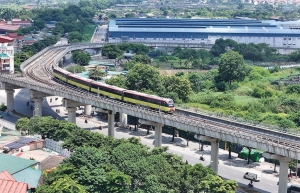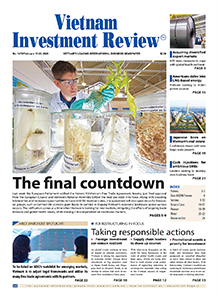$8 billion rail project set to transform transport landscape
On February 3, at a meeting to review activities discuss key tasks, Luu Quang Thin, deputy general director of the Department of Planning and Investment under Ministry of Transport, stated that the ministry (MoT) had submitted the pre-feasibility study report of the Lao Cai-Hanoi-Haiphong railway project to the prime minister.
 |
| The Lao Cai- Hanoi- Haiphong railway perspective. Photo: baodautu.vn |
The project dossier is expected to be finalised and submitted to the National Assembly before February 10. The National Assembly is scheduled to pass a resolution on the project before February 17, with the feasibility study report is set for approval in the third quarter of 2025.
The technical design phase, contractor selection, and groundbreaking for the project are planned for the end of 2025.
According to TEDI, the consulting consortium behind the project, Vietnam’s century-old railway infrastructure has become outdated despite several upgrades, increasingly losing market share, driving up logistics costs as well as road safety risk and environmental pollution, and obstructing urban growth.
This has impacted national competitiveness, prompting the 13th National Party Congress to emphasise the need for railway development as a strategic priority.
The Lao Cai-Hanoi-Haiphong railway is a key component of Vietnam’s transportation strategy, supported by diverse government resolutions such as Resolution No. 29-NQ/TW, which calls for early investment in railways connecting economic zones, industrial parks, airports, and seaports.
The national master planning has identified 13 key economic corridors, with the Lao Cai-Hanoi-Haiphong corridor ranking second in passenger and freight demand after the Eastern North-South corridor.
This route is vital for the China-ASEAN free trade area, enhancing regional integration.
The railway will link Hekou-Lao Cai international border gate with Haiphong’s international gateway port, passing through Vietnam’s nine localities that account for 20 per cent of Vietnam’s population, 25.4 per cent of its regional GDP, and 25.1 per cent of its industrial parks.
The new 1,435mm standard gauge railway will connect major urban centres, industrial hubs, and provide the shortest rail route for transporting goods from southwestern China to international seaports.
By 2050, the corridor is expected to handle 397 million tonnes of goods and 334 million passengers annually.
Railways generally are projected to manage 25.6 million tonnes of cargo and 18.6 million passengers, optimising transport market share, reducing logistics costs, and supporting sustainable growth.
The existing 1,000mm narrow-gauge railway exposes limitations, such as small curve radii and steep gradients, with an average speed of 50km/h, restricting overall transportation capacity to just 4.1 million tonnes of goods and 3.8 million passengers annually.
The project is expected to significantly boost the construction and mechanical engineering sectors, creating 90,000 jobs during construction and 2,500 permanent positions during operation, according to a TEDI representative.
The new electric-powered railway will contribute to Vietnam’s net-zero emissions goal by 2050, aligning with COP26 commitments, advanced technologies will also enhance safety and resilience against extreme weather and natural disasters.
According to the 2021-2030 railway network planning, Vietnam will have 25 railway lines totalling 6,354km, including seven existing lines and 18 new ones.
In the Lao Cai-Hanoi-Haiphong corridor, two key lines will operate: the existing 1,000mm single-track railway and the new 1,435mm double-track railway, set for development before 2030.
The prospective Lao Cai-Hanoi-Haiphong railway will span a total 403 km, comprising a main line of 388km and two branch lines totalling 15km.
As a principal trunk line of special significance within the railway system, the Lao Cai-Hanoi-Haiphong railway features international connections and is classified as a Class 1 railway with a standard gauge of 1,435mm.
The total investment capital for the project is estimated at just over $8 billion.
 | Local groups poised to work on $67-billion railway Several domestic enterprises are stepping forward to join the building materials and manufacturing segments for the North-South high-speed railway project. |
 | Assessing growth drivers in 2025 through expert lenses Nguyen Dinh Cung, former director of the Central Institute for Economic Management (CIEM), talked with VIR's Khanh An about the factors driving economic growth in 2025. |
 | SAM Holding studying a $4 billion project in Quang Tri SAM Holding JSC held a meeting with Quang Tri People's Committee on January 16 to discuss the potential development of a high-end residential, sports, and entertainment resort in the province's Gio Linh district. |
What the stars mean:
★ Poor ★ ★ Promising ★★★ Good ★★★★ Very good ★★★★★ Exceptional
 Tag:
Tag:
Related Contents
Latest News
More News
- Kolon signs $48 million airbag supply deal with Autoliv (December 15, 2025 | 18:14)
- National Assembly approves Vinh–Thanh Thuy expressway project (December 15, 2025 | 18:02)
- Quang Tri green-lights $1.59 billion LNG-fired power project (December 15, 2025 | 17:59)
- Stress laid on high-quality FDI inflows (December 15, 2025 | 11:00)
- Can Tho utilises its growth advantages (December 15, 2025 | 09:09)
- Ca Mau unlocking potential to shape a more sustainable future (December 15, 2025 | 09:02)
- Major projects to be inaugurated nationwide (December 15, 2025 | 08:00)
- MoF workshop highlights mounting concerns over ODA on-lending costs (December 12, 2025 | 16:05)
- National Assembly approves pilot mechanisms to accelerate major projects in Hanoi (December 12, 2025 | 11:29)
- Legislation gives government flexibility for loan guarantees (December 11, 2025 | 18:04)






























 Mobile Version
Mobile Version